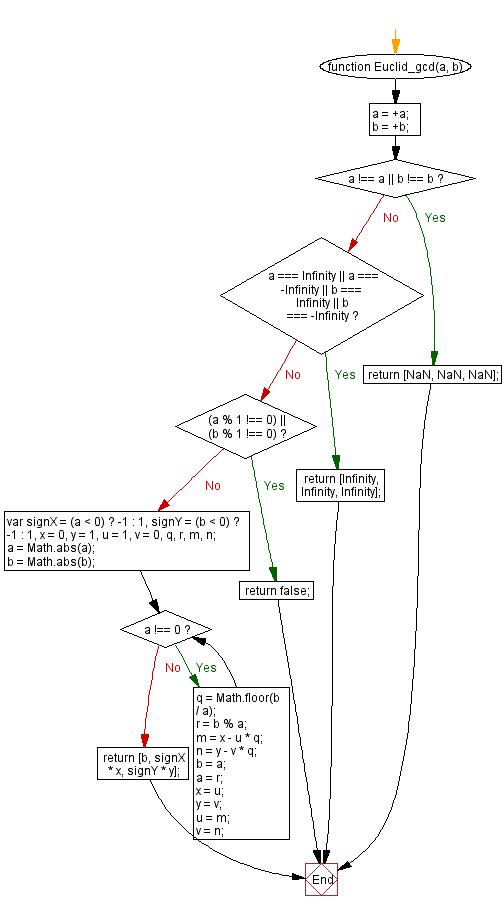JavaScript: Calculate the extended Euclid Algorithm or extended GCD
JavaScript Math: Exercise-47 with Solution
Extended Euclid Algorithm
Write a JavaScript function to calculate the extended Euclid Algorithm or extended GCD.
In mathematics, the Euclidean algorithm[a], or Euclid's algorithm, is an efficient method for computing the greatest common divisor (GCD) of two numbers, the largest number that divides both of them without leaving a remainder. It is named after the ancient Greek mathematician Euclid, who first described it in Euclid's Elements. It is an example of an algorithm, a step-by-step procedure for performing a calculation according to well-defined rules, and is one of the oldest algorithms in common use. It can be used to reduce fractions to their simplest form, and is a part of many other number-theoretic and cryptographic calculations.
Visual Presentation:
Sample Solution:
JavaScript Code:
// Define a function named Euclid_gcd that calculates the greatest common divisor (GCD) using Euclid's algorithm.
function Euclid_gcd(a, b) {
// Convert 'a' and 'b' to numbers.
a = +a;
b = +b;
// Check if 'a' or 'b' is NaN (Not a Number).
if (a !== a || b !== b) {
return [NaN, NaN, NaN];
}
// Check if 'a' or 'b' is Infinity or -Infinity.
if (a === Infinity || a === -Infinity || b === Infinity || b === -Infinity) {
return [Infinity, Infinity, Infinity];
}
// Check if 'a' or 'b' are decimals.
if ((a % 1 !== 0) || (b % 1 !== 0)) {
return false;
}
// Initialize variables for signs and quotient.
var signX = (a < 0) ? -1 : 1,
signY = (b < 0) ? -1 : 1,
x = 0,
y = 1,
u = 1,
v = 0,
q, r, m, n;
// Get the absolute values of 'a' and 'b'.
a = Math.abs(a);
b = Math.abs(b);
// Implement Euclid's algorithm to find the GCD.
while (a !== 0) {
q = Math.floor(b / a);
r = b % a;
m = x - u * q;
n = y - v * q;
b = a;
a = r;
x = u;
y = v;
u = m;
v = n;
}
// Return an array containing the GCD, and the coefficients for 'a' and 'b'.
return [b, signX * x, signY * y];
}
// Output the result of Euclid's algorithm for GCD calculation with inputs 17 and 4.
console.log(Euclid_gcd(17, 4));
Output:
[1,1,-4]
Flowchart:

Live Demo:
See the Pen javascript-math-exercise-47 by w3resource (@w3resource) on CodePen.
For more Practice: Solve these Related Problems:
- Write a JavaScript function that implements the Extended Euclidean Algorithm to compute the GCD and the Bezout coefficients.
- Write a JavaScript function that recursively calculates the extended GCD and returns an object with the coefficients.
- Write a JavaScript function that uses iteration to perform the Extended Euclid Algorithm and logs each computation step.
- Write a JavaScript function that validates input numbers and computes the extended GCD for cryptographic applications.
Go to:
PREV : Calculate Divisor and Modulus.
NEXT : Calculate Falling Factorial.
Improve this sample solution and post your code through Disqus.
What is the difficulty level of this exercise?
Test your Programming skills with w3resource's quiz.
